30 Good Dog Breeds for Apartments (With Pictures)
By Jessica Kim
Updated on

When people think of apartment dogs, they often think that small dogs are the best fit for apartment living. However, size isn’t the only thing that matters, and some small dog breeds may feel too cooped up in an apartment and require more space. There are also some larger dog breeds that can live happily in an apartment.
Some factors that make dogs a good fit for apartment life are energy level, trainability, and tendency to bark. Here are some dog breeds that are known to be good apartment residents.
Top 30 Dog Breeds for Apartments
1. Affenpinscher
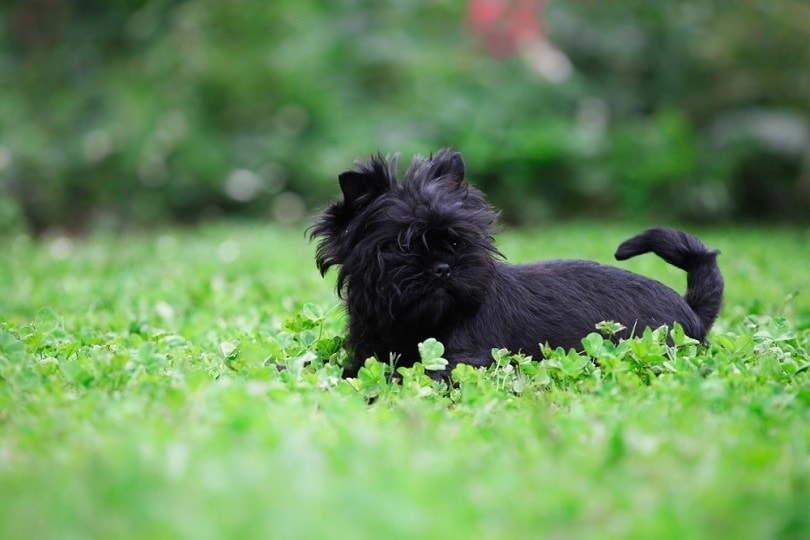
| Size: | Small |
| Energy Level: | Moderate |
| Shedding: | Low |
| Bark: | Quiet |
The Affenpinscher is a bold dog with a charming personality. These dogs make wonderful companion dogs, and they’re known to be confident and adaptable. They do have a moderate amount of energy, so they’ll appreciate daily walks or running around in a dog park. They can get by with missing a day outside as long as they get some indoor exercise through play and enrichment activities.
While Affenpinschers are an intelligent breed, they can be stubborn at times. So, they’re often recommended for dog owners that have prior experience with dog training and understanding dog behavior.
2. Afghan Hound
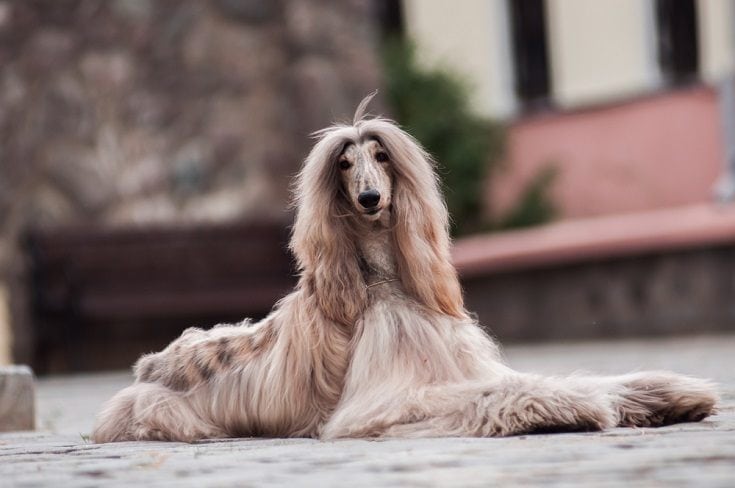
| Size: | Medium-Large |
| Energy Level: | Moderate |
| Shedding: | Moderate |
| Bark: | Low |
The Afghan Hound is an ancient dog breed that’s lived alongside humans for thousands of years. Despite their larger size, Afghan Hounds are often suitable for apartment life because they’re relatively quiet and independent. They tend to form strong bonds with their family members, but they can be quite aloof and uninterested in meeting new people or other dogs.
Afghan Hounds do have a good amount of energy and will appreciate daily walks. Since they’re not the most social dogs, they probably won’t enjoy going to a dog park unless they’re one of the only dogs there.
3. Basenji
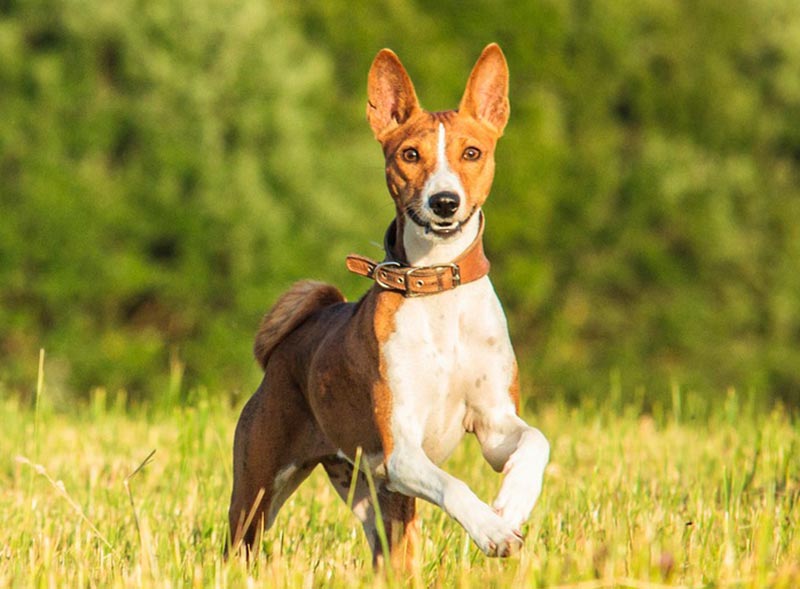
| Size: | Medium |
| Energy Level: | High |
| Shedding: | Low |
| Bark: | Low |
Basenjis can become happy apartment dwellers as long as their exercise needs are met. These high-energy dogs can be calm in the home, but they require long daily walks. They’ll also appreciate accompanying you on hikes, camping, and other outdoor activities. It’s also important to provide plenty of mentally stimulating activities because these dogs are smart and like to work.
Basenjis are relatively quiet dogs and are also known as barkless dogs. They usually only bark when necessary and won’t cause much noise in an apartment.
4. Bichon Frise
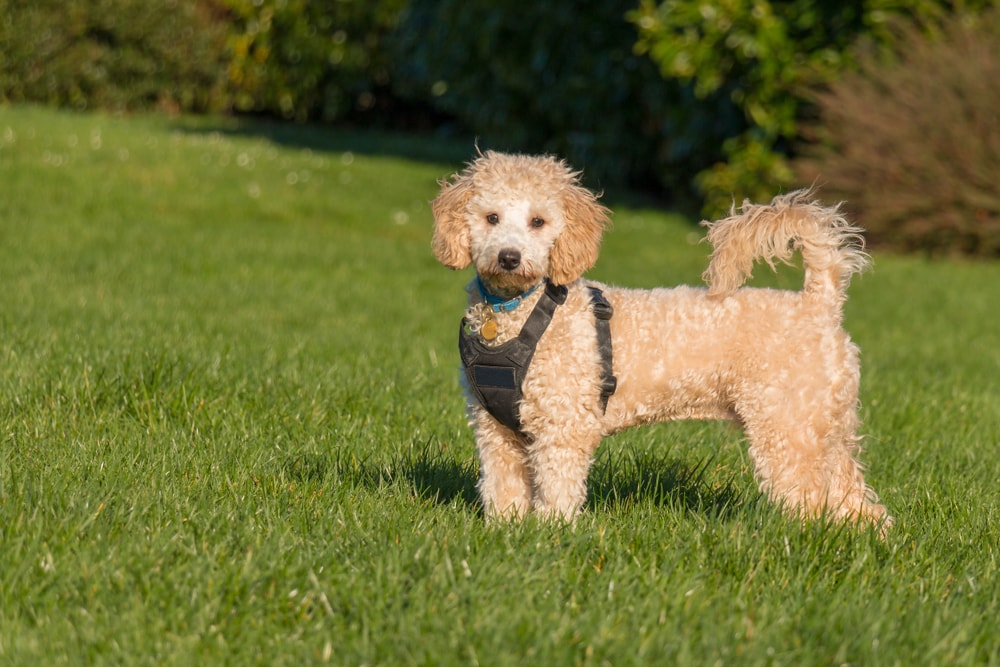
| Size: | Small |
| Energy Level: | Low |
| Shedding: | Low |
| Bark: | Low |
Bichon Frises are companion dogs that love being around people. These dogs are extremely affectionate and friendly, and they’re known to be patient with children and show interest in strangers. While they tend to have outgoing personalities, Bichon Frises aren’t loud or yappy. Their small size also enables them to live in smaller spaces comfortably. They don’t require too much exercise and can get by with skipping a daily walk as long as they get plenty of playtime and attention indoors.
5. Bolognese
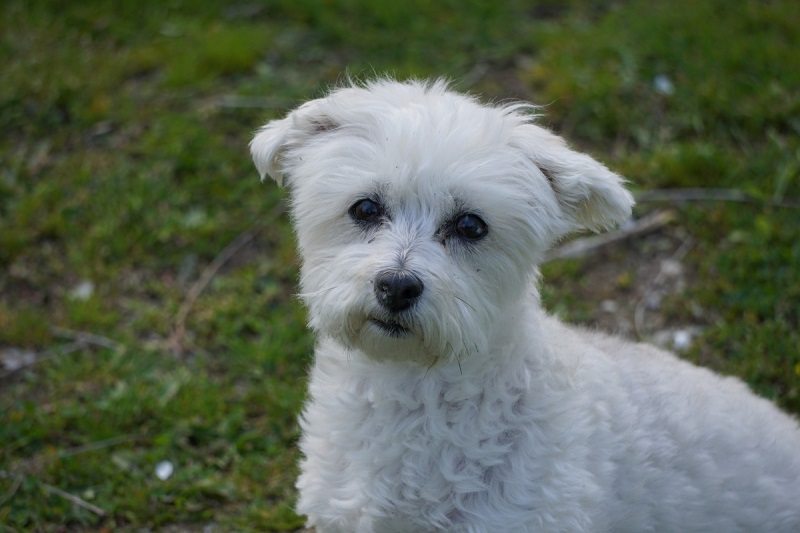
| Size: | Small |
| Energy Level: | Low |
| Shedding: | Low |
| Bark: | Low |
Bologneses make wonderful apartment dogs because they’re small and relatively quiet. They’re also very affectionate and friendly, but they can have a stubborn streak. Obedience training can be a bit challenging in the beginning, and it’s important to remain firm and consistent and keep training sessions short and fun.
While Bologneses often adapt to apartment living well, they’re quite sensitive to extreme weather. So, they don’t do well living in climates that have particularly hot or cold seasons.
6. Cairn Terrier
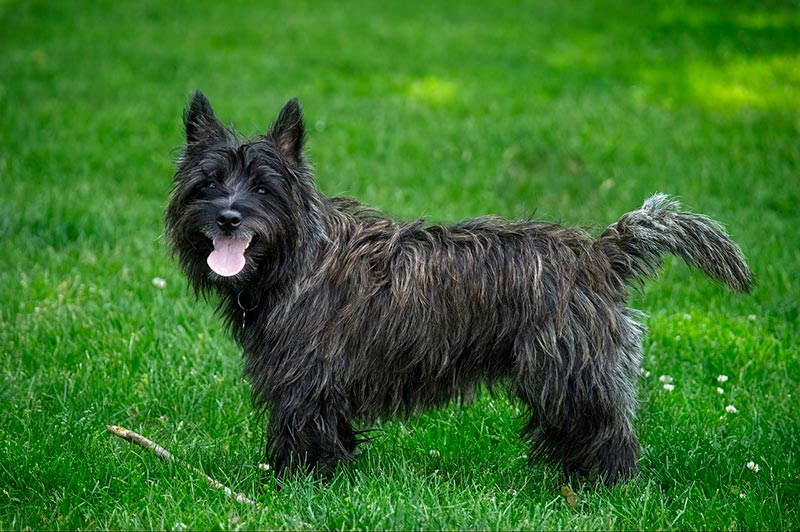
| Size: | Small |
| Energy Level: | Moderate |
| Shedding: | Moderate |
| Bark: | Moderate |
Cairn Terriers are happy, spunky dogs that love exploring and running around. They’re pretty active and require daily opportunities for walks, and they’ll also enjoy accompanying you on outdoor excursions.
These brave and confident dogs quickly become beloved members of the family, and they’re also highly patient with children. They can live happily in apartments as long as they get plenty of daily exercise and playtime.
7. Cavalier King Charles Spaniel
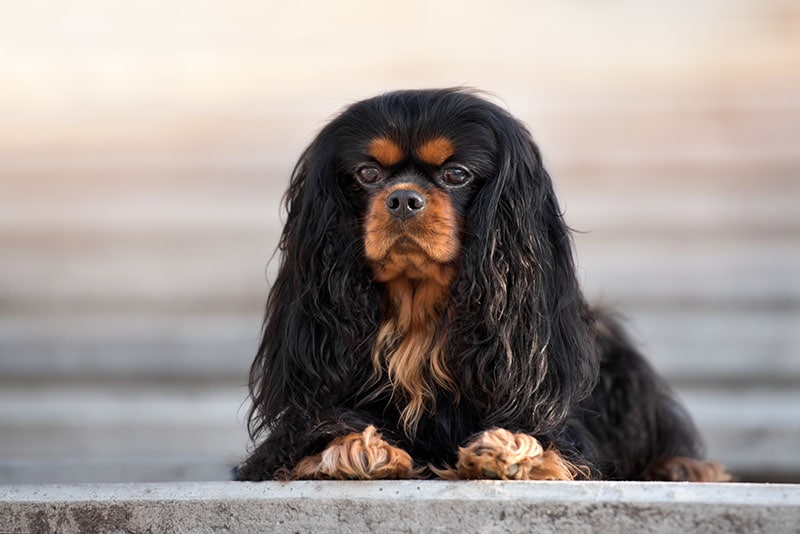
| Size: | Small |
| Energy Level: | Moderate |
| Shedding: | Moderate |
| Bark: | Low |
Cavalier King Charles Spaniels are known for their friendly and mellow temperaments. They’re excellent companion pets that enjoy being around people and are good with children. Most Cavalier King Charles Spaniels don’t tend to bark, but they might give a bark or two to let you know that someone’s at your door.
These dogs have moderate exercise needs that can get met indoors occasionally if you don’t have enough time for a walk. However, they’d much prefer going on daily walks and exploring the neighborhood.
8. Chihuahua

| Size: | Small |
| Energy Level: | Low |
| Shedding: | Moderate |
| Bark: | Moderate |
Chihuahuas can be great apartment dogs due to their size and low exercise needs. They may enjoy a short walk around the neighborhood and can also get plenty of good exercise at home. This is convenient in the winter, as Chihuahuas get cold easily.
Chihuahuas are known for their loyalty and big personalities. They’re affectionate with their families but have a loud bark for their size and may be wary of strangers. So, it’s especially important to prevent excessive barking if they live in apartments.
9. Chinese Crested Dog
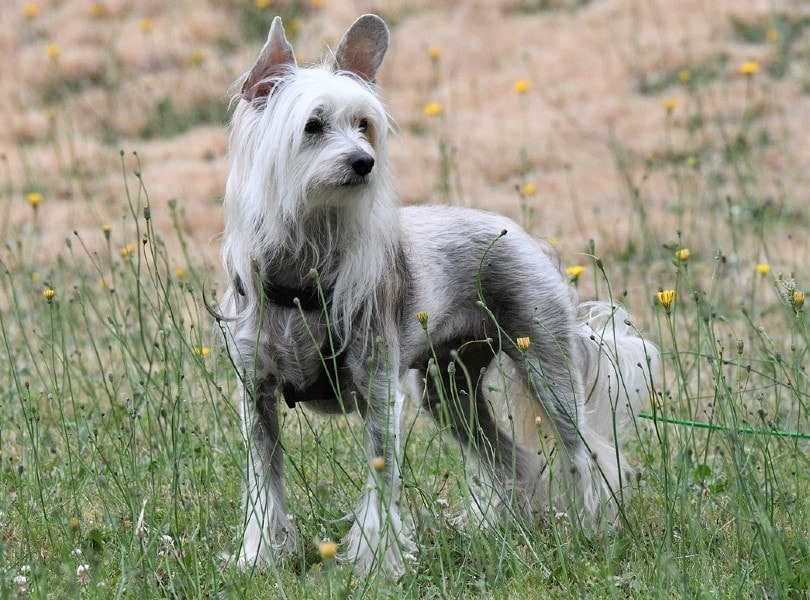
| Size: | Small |
| Energy Level: | Low |
| Shedding: | Low |
| Bark: | Low |
Chinese Crested Dogs are unique-looking dogs that are partially hairless. They often make good apartment dogs because they’re small, have low exercise needs, and aren’t known to bark. While being adaptable to apartment living, Chinese Crested Dogs are very sensitive to climate due to their lack of hair. They get cold much more easily, and they can get sunburned more easily. So, it’s important to be attentive to a Chinese Crested Dog’s needs, especially during the summer and winter months.
10. Chinook
| Size: | Large |
| Energy Level: | Low |
| Shedding: | Moderate |
| Bark: | Low |
Chinooks are known for their friendliness. They’re affectionate and loyal to their families and can be very patient with children. They’re also willing to greet new people and usually get along with other dogs.
Chinooks are also relatively quiet and aren’t known to bark, and they don’t require a particular amount of exercise. They’ll be perfectly content going on daily walks and visiting the dog park. So, despite their larger size, Chinooks are often excellent pets for apartment dwellers.
11. Coton de Tulear
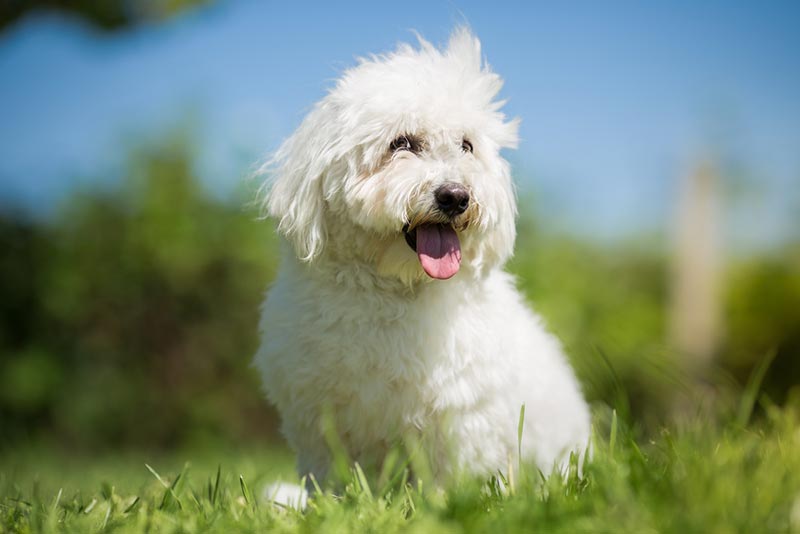
| Size: | Small |
| Energy Level: | Low |
| Shedding: | Low |
| Bark: | Low |
Coton de Tulears are popular apartment dogs because they’re small and relatively quiet. These dogs aren’t known to bark and have a low prey drive, so you typically won’t find them standing by the window and barking at everything that passes by.
Coton de Tulears love being around people and don’t do well being home alone for too long. Since they’re quite small, they’re usually pretty easy to carry around and often become pleasant companions that follow you wherever you go.
12. Dogue de Bordeaux
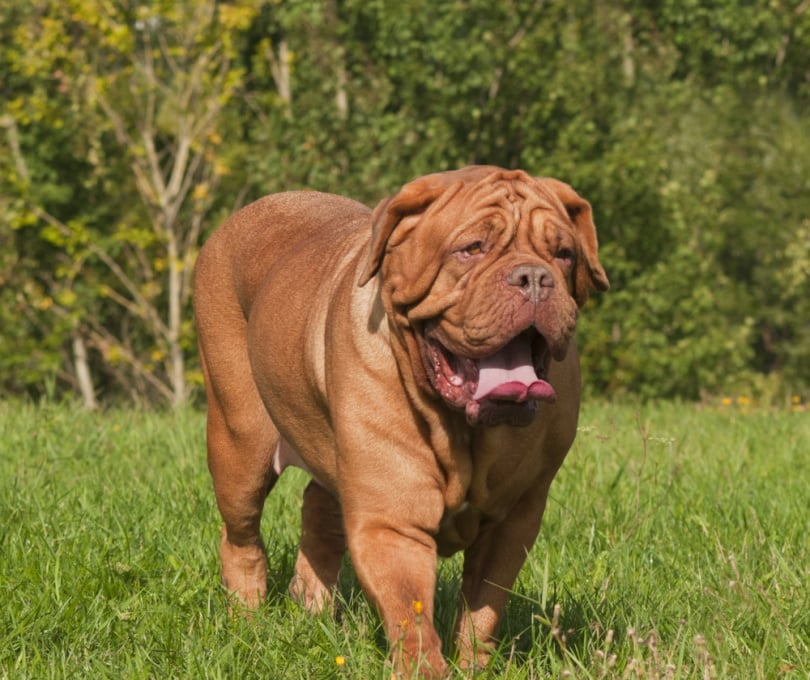
| Size: | Medium |
| Energy Level: | Moderate |
| Shedding: | Medium |
| Bark: | Low |
The Dogue de Bordeaux, or French Mastiff, is a short and stocky dog with a kind and patient personality. They’re relatively calm and quiet indoors and can adapt well to apartment living as long as they get plenty of outdoor exercise.
While the Dogue de Bordeaux can be an affectionate family dog, they can be a bit difficult to train due to stubbornness. They’re not recommended for first-time dog owners and are often best with people who can take the time to invest in proper obedience training.
13. English Bulldog
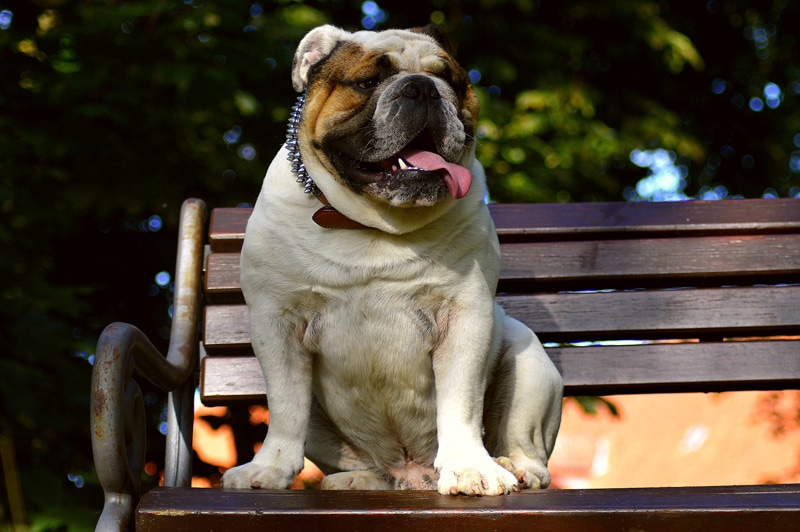
| Size: | Medium |
| Energy Level: | Low |
| Shedding: | Moderate |
| Bark: | Low |
English Bulldogs are low-energy dogs that are often content living in apartments. They’re affectionate companions that love being around people, but they often prefer being the only dog in the home.
While English Bulldogs are friendly and devoted, they’re often not recommended for beginner dog owners. They tend to have specific health needs that require extra attentiveness and care. So, they’re better suited for people who have experience living with dogs and understand dog behavior and care needs.
14. English Cocker Spaniel
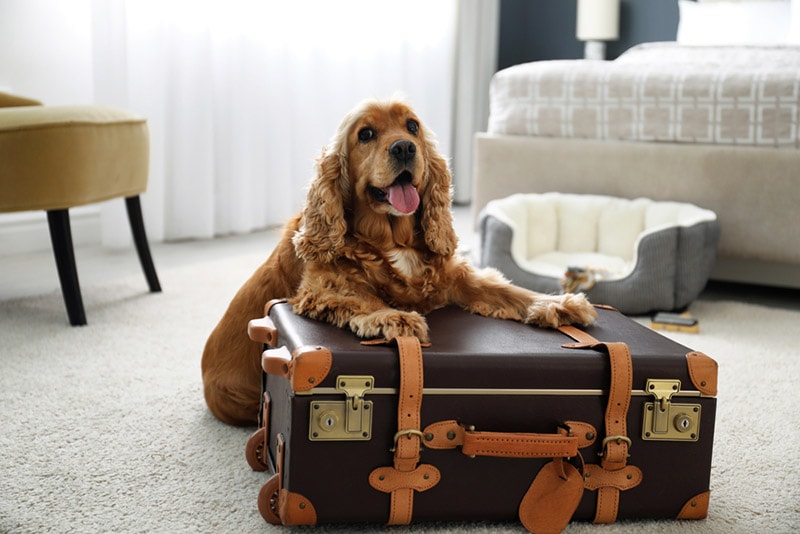
| Size: | Medium |
| Energy Level: | Moderate |
| Shedding: | Moderate |
| Bark: | Moderate |
English Cocker Spaniels are warm and affectionate, and they love human companionship. These dogs are devoted to their families, and they’re friendly toward strangers and other dogs. English Cocker Spaniels are energetic and playful and will appreciate going on daily walks where they can explore their neighborhood. They usually remain quiet and won’t bark if they’re feeling content. They can adapt well to apartment living as long as they get plenty of exercise and mental stimulation.
15. French Bulldog

| Size: | Small |
| Energy Level: | Low |
| Shedding: | Moderate |
| Bark: | Low |
French Bulldogs are known to adapt well to apartment living. They don’t have a tendency to bark, but they can develop a habit if they find out that it gets attention. These dogs love receiving attention and are great at figuring out how to receive it.
French Bulldogs aren’t highly energetic dogs and are prone to excessive weight gain and obesity. So, it’s important to let them exercise daily without overexerting themselves.
16. Greyhound
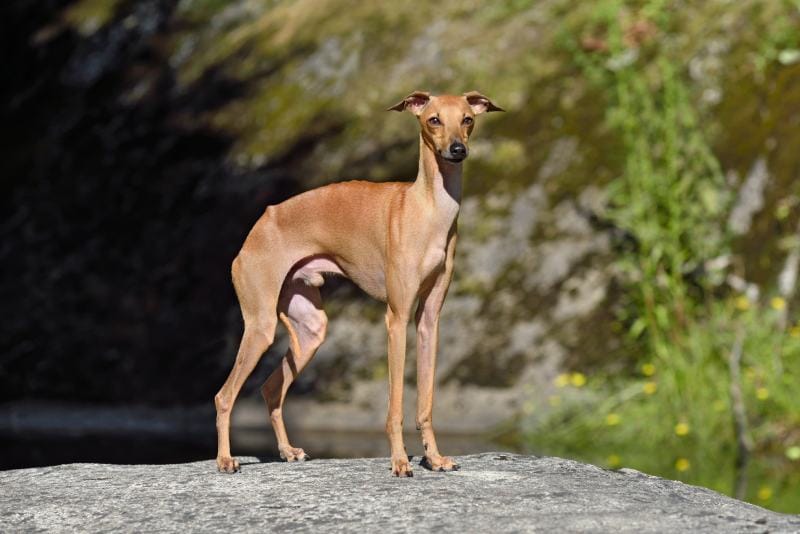
| Size: | Medium-Large |
| Energy Level: | High |
| Shedding: | Moderate |
| Bark: | Low |
Both Greyhounds and Italian Greyhounds are excellent apartment dogs. Greyhounds have quiet personalities and aren’t known to bark, so they’ll usually stay quiet, even if they hear footsteps and other noises outside of their apartment unit.
It’s important to note that Greyhounds have a lot of energy, so it’s important to take them on daily walks and provide opportunities to run around. As long as their exercise needs are met, they can live happily in an apartment.
17. Havanese
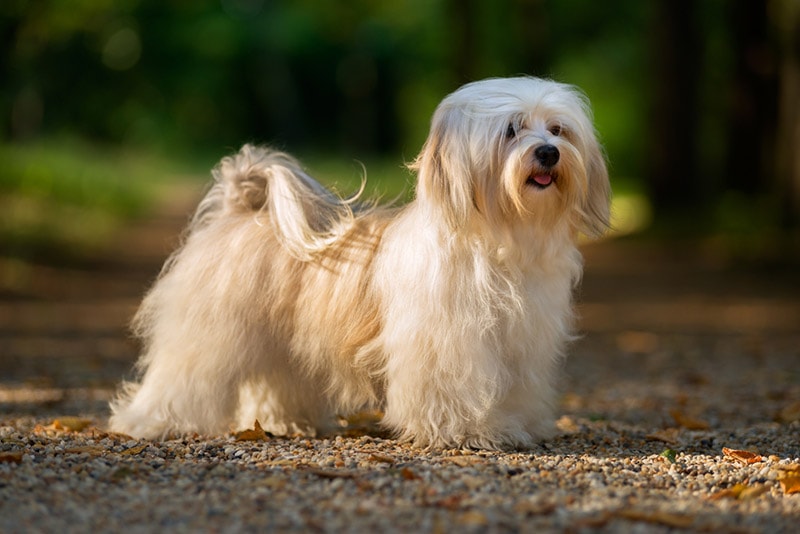
| Size: | Small |
| Energy Level: | Moderate |
| Shedding: | Low |
| Bark: | Low |
Havaneses are fun and playful dogs that love receiving attention. They’re also eager to please and easy to train, so they make excellent pets for first-time dog owners. Havaneses can have bursts of energy, especially as puppies, and they appreciate going on walks and running around in the dog park. However, they usually mellow out as they age, and they become good apartment dogs that like to relax and spend time at home with their owners.
18. Japanese Chin

| Size: | Small |
| Energy Level: | Low |
| Shedding: | Low |
| Bark: | Low |
Japanese Chins can live happily in apartments. They’re not known to be loud barkers, and they don’t require as much exercise as more active dog breeds. However, Japanese Chins are also pretty adaptable and are known for taking on the lifestyle of their owners. So, they can grow to become couch potatoes or active dogs that enjoy being outside.
While they’re affectionate and intelligent, Japanese Chins don’t excel in obedience training. They tend to have a mind of their own, and it usually takes them a longer time to learn basic obedience commands.
19. Lhasa Apso
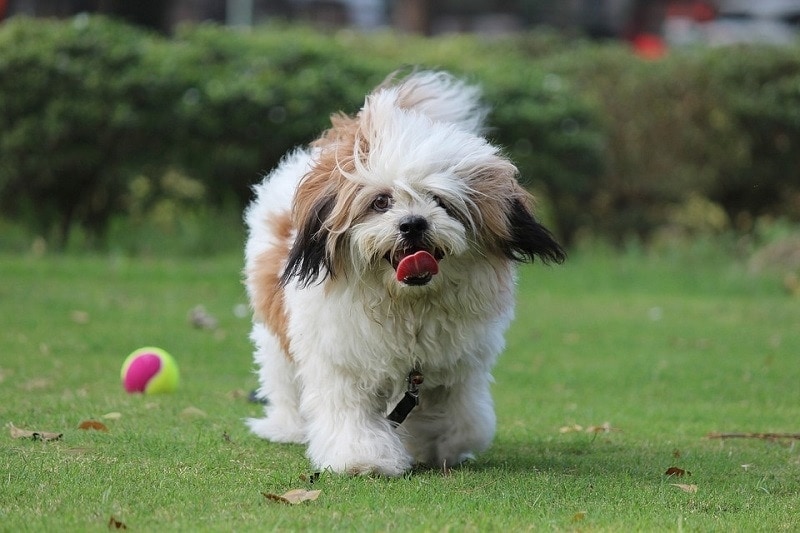
| Size: | Small |
| Energy Level: | Low |
| Shedding: | Low |
| Bark: | Moderate |
Lhasa Apsos are wonderful family dogs that typically form strong bonds with their family members. While they’re affectionate and playful with their families, they’re known to be more reserved around strangers, and they prefer being the only dog in the home.
Lhasa Apsos can develop a habit of barking, but this can be reduced with adequate training and exercise. They love spending time with people and playing, and if these needs aren’t met, Lhasa Apsos can start to bark to get your attention.
20. Maltese

| Size: | Small |
| Energy Level: | Low |
| Shedding: | Low |
| Bark: | Low |
Maltese are popular apartment dogs because they’re small, quiet, and have relatively low exercise needs. Because Maltese can be quite content spending all day at home, it’s important to be on top of socializing them so that they grow comfortable and confident in various settings and interactions.
Fortunately, Maltese have naturally friendly temperaments, so they can easily get along with other dogs. They also don’t mind being the center of attention and are often hospitable hosts whenever guests are in the home.
21. Miniature Dachshund

| Size: | Small |
| Energy Level: | Moderate |
| Shedding: | Moderate |
| Bark: | Moderate |
Both Standard Dachshunds and Miniature Dachshunds can adapt to apartment living, but Miniature Dachshunds tend to be the better fit because of their smaller size. Miniature Dachshunds are charming and playful and are sure to bring plenty of entertainment and laughter into the home. These dogs will love going on daily walks, but they can get by with missing a day as long as they get indoor exercise.
Miniature Dachshunds come from a breed of hunting dogs, so they can develop a habit of barking or howling. Starting obedience training early can help prevent excessive barking and other unwanted behaviors.
22. Miniature Poodle

| Size: | Small |
| Energy Level: | Moderate |
| Shedding: | Low |
| Bark: | Moderate |
Miniature Poodles are known to be eager to please and easy to train. However, they can have a lot of energy when compared to other small dog breeds, so it’s important to give them plenty of exercise opportunities.
Miniature Poodles are also extremely intelligent and can get bored easily. Bored dogs can develop a habit of excessive barking, so if you’re interested in bringing home a Miniature Poodle, make sure you’re able to incorporate both physical and mental exercise into their daily routine.
23. Papillon
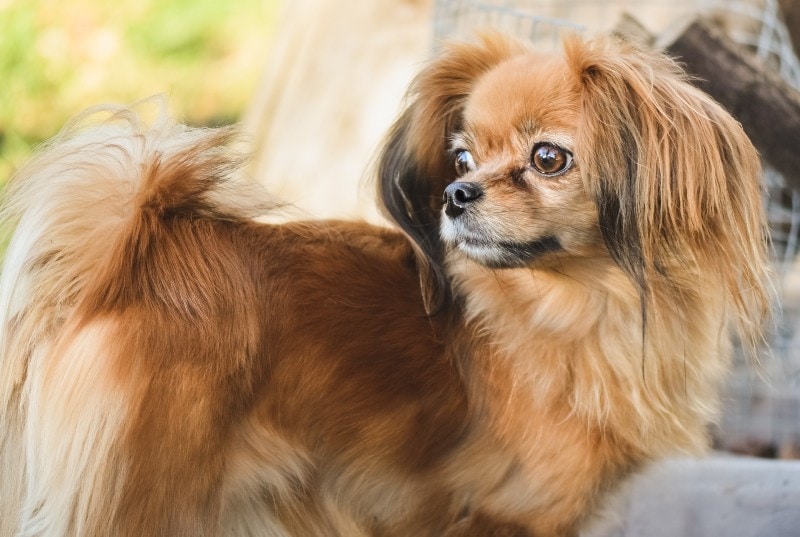
| Size: | Small |
| Energy Level: | Moderate |
| Shedding: | Moderate |
| Bark: | Low |
Papillons are small companion dogs that would love nothing more than to accompany their favorite people everywhere. These playful dogs can have bursts of energy, but they usually adapt to apartment living fairly well because of their small size.
Papillons are also pretty quiet and aren’t known to be barkers. They’re also pretty easy to train and are viable choices for first-time dog owners.
24. Pekingese

| Size: | Small |
| Energy Level: | Low |
| Shedding: | Low |
| Bark: | Moderate |
Pekingeses are relatively calm dogs with low exercise needs. However, they have a strong prey drive and are sensitive to strange noises, so they can develop a habit of window-watching and barking at people and animals that pass by. Because of this, they tend to be more well-suited for quieter apartments or living in units located on the upper levels of high rises.
Other than the potential for barking, Pekingeses are well-suited for apartment life. They’ll enjoy going on short walks, but they often prefer relaxing and napping at their favorite spots.
25. Pomeranian
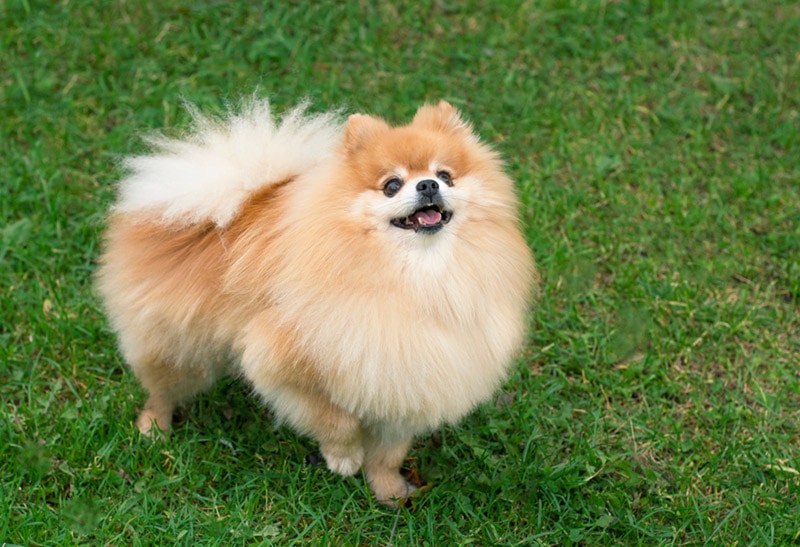
| Size: | Small |
| Energy Level: | Low |
| Shedding: | Moderate |
| Bark: | High |
Pomeranians are popular for their small size and devoted personalities. They become extremely attached to their families and love receiving attention. They also prefer being in homes with older children and no other pets.
Despite being tiny, Pomeranians are bold and won’t hesitate to alert you if they see someone approaching your home. So, it’s important to work on training your Pomeranian to regulate their barking. Fortunately, Pomeranians are relatively easy to train, and they typically respond well to praise and rewards.
26. Pug
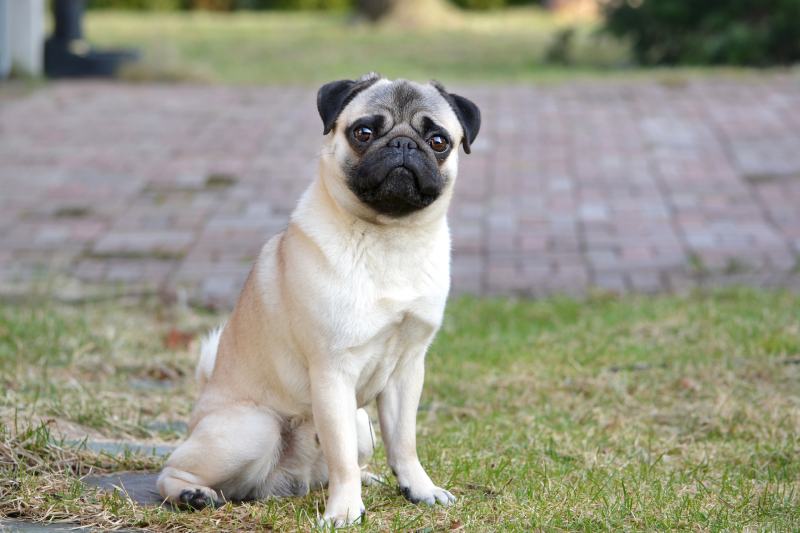
| Size: | Small |
| Energy Level: | Low |
| Shedding: | Moderate |
| Bark: | Low |
Pugs are another excellent candidate for apartment living. They’re relatively quiet and have low energy levels. These charming dogs are also usually friendly with all people, and they love to play and entertain.
It’s important to keep in mind that while Pugs aren’t known to be yappy, they can develop a habit of barking excessively if they’re left alone for too long. These dogs need a lot of human companionship and can develop separation anxiety and bark and howl when they’re consistently home alone for long hours.
27. Shiba Inu
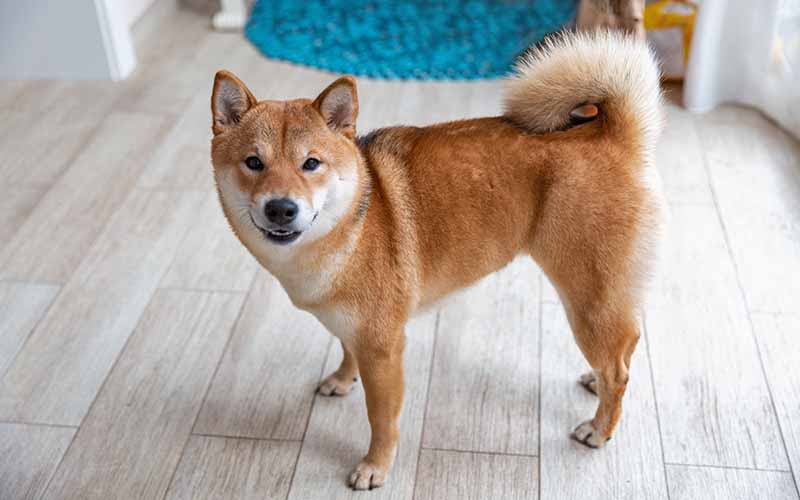
| Size: | Medium |
| Energy Level: | Moderate |
| Shedding: | High |
| Bark: | High |
Shiba Inus are independent dogs that are affectionate towards their families, but they usually don’t bother with strangers and will keep to themselves. While Shiba Inus have grown in popularity, they tend to be freethinkers with a mind of their own. So, they’re often better fits for experienced dog owners.
While Shiba Inus may not pay much attention to people walking down the sidewalk, they can have a strong prey drive and start barking at small neighborhood animals like squirrels and rabbits. So, it can be helpful to keep your windows covered whenever you leave the house to prevent your Shiba Inu from barking excessively while you’re out.
28. Shih Tzu

| Size: | Small |
| Energy Level: | Low |
| Shedding: | Low |
| Bark: | Moderate |
Shih Tzus are tiny dogs with big personalities. They can certainly hold their own, but they’re also extremely affectionate toward people. They’re popular apartment dogs because of their small size, and they often end up becoming very entertaining roommates.
Shih Tzus are very playful and love being the center of attention. While they’re not known to be loud barkers, they can develop a habit of barking if they learn that it gets your attention.
29. Whippet
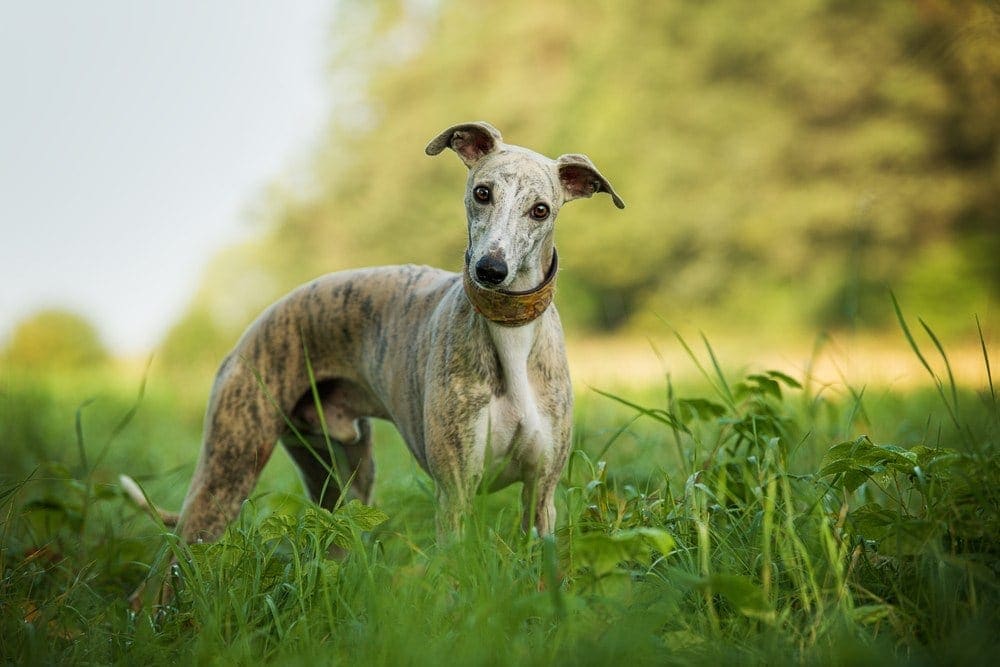
| Size: | Medium-Large |
| Energy Level: | Moderate |
| Shedding: | Low |
| Bark: | Low |
Whippets are another larger dog breed that adapts well to apartment life. They do have higher exercise needs, but they’re relatively quiet and aren’t known to bark or growl. So, as long as you’re able to take a Whippet out for daily walks, they can live a happy and content life in an apartment.
Whippets also have friendly temperaments and are usually easy going with children, strangers, and other dogs. However, they’re not as adaptable to extreme weather and get cold easily.
30. Yorkshire Terrier
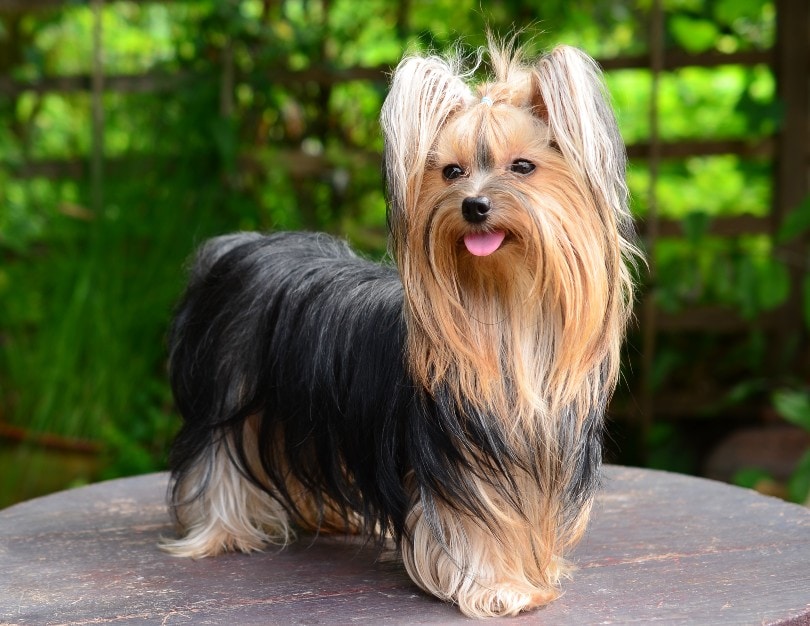
| Size: | Small |
| Energy Level: | Low |
| Shedding: | Low |
| Bark: | Moderate |
Yorkshire Terriers are highly loyal companion dogs that love nothing more than spending all day with their favorite people. They’re excellent dogs for apartment living because of their small size and relatively low energy. They may appreciate a brisk walk around the neighborhood, but many can get their exercise needs met through indoor play.
It’s important to make sure to train a Yorkshire Terrier not to bark or redirect their attention whenever they hear unexplainable noises. These alert dogs can develop a habit of barking if they hear people walking past apartments or see something intriguing outside the window.
Conclusion
Many different kinds of dogs can live happily in apartments. Rather than size, it’s important to make sure that your dog’s temperament and personality are suited for apartment living. Typically, dogs with lower energy and less tendency to bark are better fits than highly active breeds or watchdogs with loud barks.
While all dogs will require training, some are naturally more adaptable and don’t mind living in smaller spaces. So, before you commit to bringing home a dog, make sure to find one with a personality and temperament that matches both your living space and lifestyle.
Featured Image Credit: Steshka Willems, Pexels











